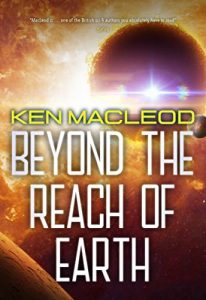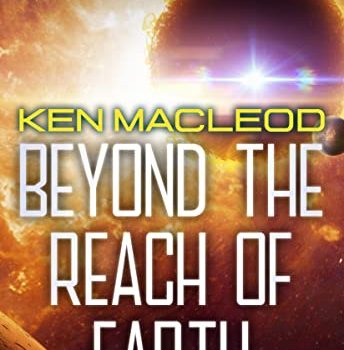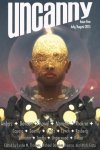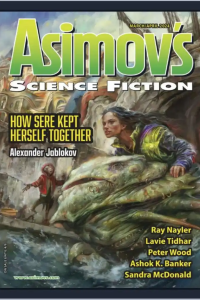Russell Letson Reviews Beyond the Reach of Earth by Ken MacLeod
 Beyond the Reach of Earth, Ken MacLeod (Orbit 978-0-356-51480-2, £10.99, 336pp, tp) March 2023. Cover by Duncan Spilling. (Pyr 978-1-64506-665-9, $21.00, 334pp, tp) July 2023.
Beyond the Reach of Earth, Ken MacLeod (Orbit 978-0-356-51480-2, £10.99, 336pp, tp) March 2023. Cover by Duncan Spilling. (Pyr 978-1-64506-665-9, $21.00, 334pp, tp) July 2023.
I reviewed the opening volume of Ken MacLeod’s Lightspeed Trilogy, Beyond the Hallowed Sky, back in 2022, but I didn’t see the second volume, Beyond the Reach of Earth, when it appeared last year. Now, though, I have it and the final volume, Beyond the Light Horizon, to review together. This accidental scheduling makes it easier to see that these three books (like The Lord of the Rings or MacLeod’s own Corporation Wars trilogy) constitute a single long, complex story, broken into multiple movements, with pauses rather than full resolutions at the end of each.
The first volume is a busy, heady mix of science-fictional and intrigue-thriller motifs, and the continuation manages to raise the ante on all of them. The main story begins with the revelation that, starting in 2018, FTL travel was developed, interstellar expeditions were mounted, and at least one habitable and living exoplanet, Apis, was discovered. But these discoveries and explorations have been kept the deepest, darkest of secrets by a quasi-official international conspiracy called Black Horizon. In 2067, mathematician Lakshmi Nayak has received an impossible letter from an apparent future self with the FTL equations. When Scottish shipbuilder and entrepreneur John Grant stumbles onto the existence of nuclear submarines fitted out as starships, he organizes a company to build one using Nayak’s FTL drive design. Later, Grant’s son Myles and his partner Marie wind up on Apis with a group of settlers – and discover involuntary colonists who have already been there for generations.
By the 2070s the world order has reorganized around three dominant blocs: the Alliance, roughly the US/UK “plus India and minus Ireland and Scotland”; the Co-ordinated States (“Co-ord”) of the old Communist world of Russia and China plus Cuba; and the new kid on the blocs, the former-EU-based Union of European states (plus Ireland and Scotland) that emerged after a Cold Revolution instituted a worker-led regime of “economic democracy” that merges libertarian and Marxist principles and models. (An African Union stands to one side of this dominant-power triad, but that is subject to change.) The intrigue side of the story is rooted in these global rivalries becoming interstellar as all three blocs compete for control of the powers and resources released by star travel.
Star travel is not the only science-fictional enabling device at large in this story. Venus is being explored from an orbital station and from a Cloud City habitat afloat in its atmosphere. Down on the planet’s hellish surface are rock formations that seem to harbor enigmatic and scarily powerful alien intelligences, eventually called the Fermi, that seem to have been embedded for billions of years in similar formations that are also found on Earth and Apis and eventually other extrasolar locations. The Fermi are not very communicative, though they make it clear, via literally earth-shaking actions, that there are matters with which humans are not to mess. Nevertheless, humans do mess, by establishing settlements on Apis and poking around in star systems that show evidence of having been engineered and even seeded with terrestrial-descended life, presumably by the Fermi.
Other crucial technological advances have occurred in artificial intelligence and robotics. For example, the Union’s omnipresent, networked “predictive AI” assistant, Iskander, is a super-Siri that not only answers questions and carries out routine tasks but anticipates users’ needs so well that one hardly needs to ask – Iskander will have arranged your travel reservations or re-ordered your favorite groceries, or even managed your interstellar navigation – all via a conversational user interface that sounds and acts like a person.
Questions surrounding the nature of artificial intelligence are particularly prominent and persistent – whether AI can be reflective and “conscious” or is merely a matter of very, very good simulation. No one in the Union seems to find the ubiquitous, helpful Iskander anything but an enormous convenience, but then there is the Alliance’s very-human-appearing robotic not-so-secret-agent Marcus Owen, whose physical appearance and interpersonal social behavior are good enough to make him not only a charming cocktail-party conversationalist but a convincing lover. Owen’s behavioral repertory is completely convincing, despite his repeated assertions that there really is no self-aware person inside the utterly human-seeming (but inhumanly powerful and durable) body. His designers insist that
consciousness was (it turned out) superfluous to intelligent conversations…. The robots themselves, when asked, agreed with their makers. Robots, they would tell you, could chat about your inner states and theirs… but if pressed they would admit they didn’t have a clue what they were talking about.
Nevertheless, Owen’s viewpoint sequences do not feel very different from those of any other character, though to be sure, his absolute and unflinching fidelity to his instructions (which can include murder) have the effect of keeping that question open. As do the activities of Iskander’s various instances and versions on Earth and on Apis, which always seem to be intentional in the human sense. The nonhuman (or inhuman) Fermi are enigmatic and terrifyingly powerful, but these human-devised AIs are somehow stranger in their mimicry of human behavior. And when the Fermi interact with the AIs, the strangeness increases significantly.
In Beyond the Reach of Earth, Apis has been occupied not only by human settlers but also military elements aiming at control of the planet’s Fermi-haunted geological formations. The Union’s Venus Space Station, having mounted an FTL drive, has become a star-traveling habitat/vessel capable of surveying promising solar systems. The results of all these expeditions, explorations, and travels keep broadening the list of the books’ many puzzles: the nature of the Fermi; the mysterious physics of FTL travel and the possibility of time travel; the distantly Earth-descended ecosystem of Apis and its apparently intelligent, tool-making, and beekeeping arachnoid “monkey-spiders.” (And where did those bees come from?) These intertwined and interacting motifs, tropes, and puzzles make for a complicated, intertwined story line encompassing multiple First Contacts, extrasolar exploration, planetary pioneering, socio-economic-political modeling (and intrigue), and a generous dash of cosmological speculation.
For all the intrahuman, interbloc rivalries and maneuvers and intrigues, the intellectually gripping elements of the novel are in the confrontations of humankind in general with the mysteries of alien ecologies; with inhuman or transhuman or artificial minds; with the nature of a Nature that shows signs of design or even engineering; with the question of how to find a place for ordinary humankind in such a universe.
Which is not to say that the foreground, human-centric action is routine. The large cast of scientists, explorers, pioneers, soldiers, spies, political operatives, and adventurous personalities of all kinds supply plenty of vigorous physical action: chases and escapes, skirmishes, earthquakes and tsunamis, and exploratory treks through the often-uncanny landscape of Apis. Then there’s an encounter with a human tribe that has been on the planet since before Black Horizon got there; discoveries of human activity on a number of extrasolar locations (including the “Mushroom Moon,” where everybody is permanently higher than a kite on Fermi-engineered fungi); changes in Marcus Owen’s role and mentality; and finally a cliffhanger of an FTL trip that leaves John Grant in the right place but the wrong time, confirming Lakshmi Nayak’s suspicion about FTL and time travel.
Russell Letson, Contributing Editor, is a not-quite-retired freelance writer living in St. Cloud MN. He has been loitering around the SF world since childhood and been writing about it since his long-ago grad school days. In between, he published a good bit of business-technology and music journalism. He is still working on a book about Hawaiian slack key guitar.
This review and more like it in the June 2024 issue of Locus.
 While you are here, please take a moment to support Locus with a one-time or recurring donation. We rely on reader donations to keep the magazine and site going, and would like to keep the site paywall free, but WE NEED YOUR FINANCIAL SUPPORT to continue quality coverage of the science fiction and fantasy field.
While you are here, please take a moment to support Locus with a one-time or recurring donation. We rely on reader donations to keep the magazine and site going, and would like to keep the site paywall free, but WE NEED YOUR FINANCIAL SUPPORT to continue quality coverage of the science fiction and fantasy field.
©Locus Magazine. Copyrighted material may not be republished without permission of LSFF.








